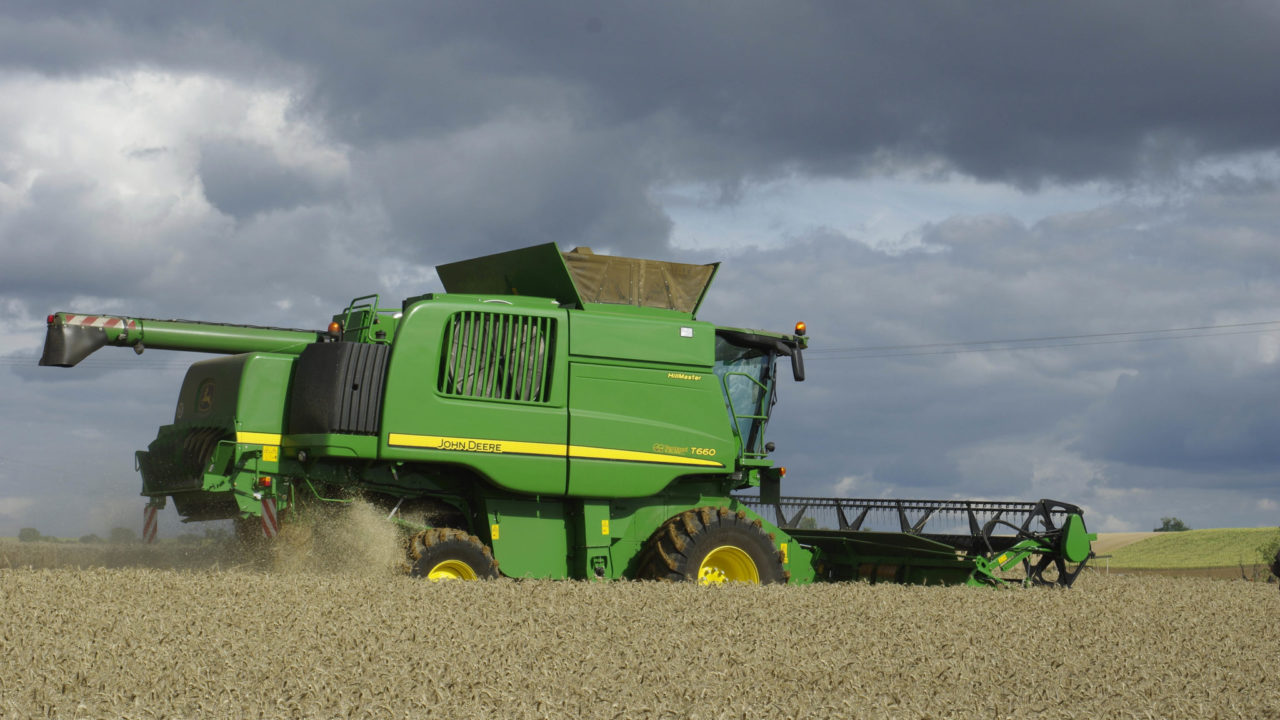John Deere has been in the business of making harvesting machinery since 1909, yet it has come long way since, producing its first self-propelled machine in 1947.
It was in 1924, after strong internal dissent, that the company set out to enter the world of what was then referred to as ‘combination harvesting’, a whole new approach to gathering crops.
Horse-drawn harvesters
The machinery technology of the time brought together stationary threshers from the barn and reapers from the field, to create a machine that would cut and thresh the crop as it worked its way across the land.

By 1927 Deere’s first two machines appeared; these were solidly built and the design had been greatly influenced by the Massey Harris units that were already out working on the prairies.
It turned out they were in fact a little too solidly built, and so lighter versions, which could be better handled by the low horse power tractors of the time, were ushered in a couple of years later.
The Caterpillar connection
One of the company’s competitors during this period was Caterpillar which had inherited combine production from the Holt Manufacturing Company.
It had in fact offered its combine business to Deere in 1926 for $1.2 million, but this was considered too steep a sum to gain entry into the market at the time.

A fresh round of cooperation between the two companies during the 1930s resulted in Caterpillar virtually giving away its hillside model to John Deere, which didn’t have one in its line-up, in 1936.
Although this sounds a rather charitable move, the crawler company was then able to concentrate on the rapidly expanding construction industry while keeping its past farming customers sweet.
John Deere was able to immediately gain a large slice of the market, especially in the west, plus all the engineering expertise which had gone into the Holt combines, considerably boosting its capabilities.
Self-propelled in South America
It was at about this time that Massey Harris started experimenting with a self-propelled combine in Argentina. Up until this moment, nearly all combine harvesters had been drawn by horse, mule or tractor, with an auxiliary engine powering the threshing mechanism.

The Massey Harris type 21A, introduced in 1938, changed all that and with the declining availability of manpower brought about by the war, and the post-conflict boom in manufacturing drawing even more labour from the fields, self-propelled machines were suddenly in demand.
John Deere responded in 1947 with its Model 55, its first self-propelled machine which contained many of the design principles still found into today’s machines.
First principles
These include a driver’s station placed centrally and positioned well above the header to give a clear view of the reel and table.

The engine is placed behind the driver, as is the 2,000L grain tank which was a standard item right from the start, bagging being left behind with the horse-drawn machines.
Self-propulsion also ushered in longitudinal crop flow from the header to the three straw walkers, as there was no need to leave room for a drawbar on one side.
The threshing drum was 76cm wide and it was powered by a 71hp petrol engine, which then, as now, was considerably greater in size than the average tractor of the day.
Big seller
The Model 55 is Deere’s longest running combine with 84,000 units built over the 22 years it was made, suggesting that the engineers had hit upon a magic formula right at the start.

It finally gave way to the ‘New Generation’ combine series in 1969, although it had been joined in the range by both smaller and larger models throughout the two decades of its life.
The story of Deere’s combine harvesters might then appear a simple one of acquisition and progression in the U.S, leading to further success in overseas markets, but there was a further twist added in France around 1960.
CCM, JD and the EEC
In 1957, the treaty of Rome ushered in the common market, doing away with many trade barriers within Europe, while erecting them with the rest of the world.

In France, three small machinery companies pooled their resources in a bid to become large enough to compete with the competition that was expected to come from elsewhere on the continent.
The new company was called CCM and, by chance, John Deere got to hear of the new firm. Deere had become concerned that new tariffs would increase the cost of engines shipped from the U.S to its newly acquired facility at Mannheim.
Tariff troubles
One answer was to manufacture the engines within the new trading bloc, so it was quickly decided to join forces with CCM by taking a 51% share in the new venture, which went ahead in 1960.

There were other advantages to Deere, one being that the equipment manufactured by the three companies would be sold in the green and yellow livery, giving it a ready-made range of machinery suitable for European conditions.
Another was that one of the French companies had been making a combine harvester under licence from Jeantil (another combine manufacturer); this machine had one or two novel features but struggled in adverse conditions due to its ‘squirrel cage’ cleaning system.
Ahead of its time
The original model was known as the D25 and it had augers beneath the straw walkers rather than an oscillating pan. This worked well on hillsides and was taken up by both JD and International Harvester in later years.
The problems arose with the roller separators which replaced the upper sieve on the drum. These were known colloquially as ‘squirrel cages’ and they tended to clog when the straw was short, leading to frequent stoppages.
The arrangement lasted for two years before the internals were replaced by those from a conventional JD model 45 and the resulting combine was sold only in France as the CCM245.

